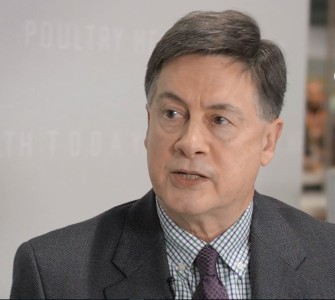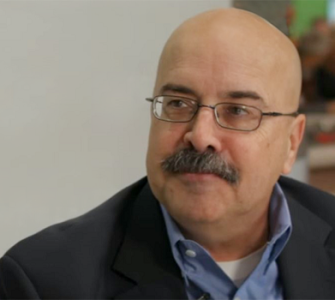Facing poultry’s consumer trust challenge
The U.S. poultry industry needs to get more engaged with consumers, said a panel of experts who discussed the challenge of building consumer trust.
By Gary Thornton
Where does poultry stand with consumers on issues such as antibiotic usage, animal welfare and food safety? What must be done to strengthen trust in poultry and the companies that produce it?
Five experts in the fields of veterinary medicine, food safety, marketing, and consumer behavior addressed these issues in a panel entitled, “Consumer trust and poultry: Bridging the gap between where we are and need to be.”
The panel was presented by WATT Global Media and sponsored by Zoetis, the global animal health company.
The experts’ conclusions included the following:
- Openness and transparency with consumers is the biggest opportunity and the biggest challenge for the poultry industry and its companies.
- The number one food safety challenge facing the U.S. poultry industry is to reduce Salmonella in poultry parts.
- The poultry industry needs to step up its engagement in the consumer dialogue through social media, which requires investment by individual companies and increased funding for trade organizations.
- Communicating simpler, more compelling messaging to consumers on the issues that concern them the most is the key to changing consumer misperceptions about poultry.
It is critically important to help consumers have a more meaningful understanding of poultry products, labeling and the industry’s farming practices.
What are the trust issues for poultry?
Alan Sterling, director of marketing, Wayne Farms, said, “Consumers, by and large, want to trust their source of food. They want to know where it comes from, and they want to believe that it is safe.
“Research indicates that they don’t necessarily want to know how their food was prepared or produced, unless they have a reason to doubt us, and when doubt enters the equation trust is eroded.”
The rise in the usage of social media has contributed to consumer misunderstanding of poultry, because misinformation shared there too often goes unchallenged, Sterling said.
“The poultry industry has been absent from a lot of that conversation, and we have lost some of the trust consumers had in the industry simply because we chose to back off or stay away from difficult topics,” he said.
Consumers have questions about poultry
Consumers have a great number of questions about poultry and how it is produced, said Dr. Bruce Stewart-Brown, senior vice president of food safety, quality and live operations at Perdue Farms.
“[At Perdue Farms], we get well over 2,000 calls a month from consumers about different things. We catalog them and characterize them and try to understand what the concerns are. And the subset of those inquiries that has to do with issues has gone up a third in the last year,” he said.
Those questions are taken seriously, and the company tries to answer them in a way that consumers can understand, Stewart-Brown said.
“We also have more people in [to visit Perdue Farms facilities] to see what is going on,” he said. “Most people would just like to see some things that we are doing and try to understand them to a degree.
“The other thing is that we have embraced the part where consumers say, ‘Yes, I get what you do and that you have a history of quality and food safety, but we would like for you to be open with other people looking at your operation.’ So we have embraced having third-party audit groups come in [our operations], particularly the government through the USDA Process Verified Program that we have been working on for the past few years.”
Issues that concern consumers
The five panelists named what they believe are the three most significant consumer trust issues for poultry.
Dr. Carl Heeder, regional business director: turkey, water solubles, food safety, Zoetis, named farm practices, antibiotic use and food safety as three top consumer issues.
“As an industry, we don’t allow a lot of people into facilities. I spent some time with Temple Grandin a few years ago, and her suggestion was that we bring people into our facilities as well as have webcasts so they can see where the animals are raised and the quality of the conditions under which most of them are raised,” he said.
Dr. Michael P. Doyle, director of the Center for Food Safety at the University of Georgia, believes consumers are most concerned about food safety, poultry inspection and animal welfare.
“Clearly, the toughest, the number one issue which is food safety related is Salmonella,” he said. “The poultry industry has been doing a good job in reducing Salmonella on poultry but it just isn’t good enough, so we are going to have to come up with more creative ways to do this.”
Sterling said the poultry industry should work on three things of importance to consumers: being transparent, using easier to understand language, and explaining farm practices.
“We really need to bust the myth of industrial farming versus independent farming versus some abstract notion of backyard farming,” he said.
More than facts required to convince consumers
Stewart-Brown identified three consumer priorities related to poultry:
- Safety (concern about the use of antibiotics, GMOs and other things in the feed)
- Farm practices (distrust exists as a result of biosecurity practices that keep people out of facilities)
- The need for more compelling, understandable communication with consumers
“If we thought we just needed to tell consumers the answers to certain questions and they would get it, we are wrong. We need to come up with better ways to communicate and help them understand those answers,” Stewart-Brown said.
Rich Kottmeyer, managing director, Strategic, named three things the poultry industry needs to guard against in order to be able to start building greater trust with consumers:
- Mixed brand messaging in which people are encouraged to mistrust all but the highest-end poultry products
- Barfing of science on consumer issues
- Playing catch-up defense versus a considerate offense on consumer issues
“Consumers like a simple story,” he said, “but agriculture tends to try to prove a point in its communications with them as opposed to simply telling a story.”
Food safety and consumer trust
The issue of Salmonella continues to be the toughest food safety issue for the poultry industry, and it is an issue of considerable public concern.
While the presence of the organism on poultry whole carcasses has been markedly reduced in recent years, its presence on poultry parts continues to cause human illnesses tracked by the Centers for Disease Control.
“Until the industry can come up with more immediate solutions for reducing Salmonella on poultry parts, consumers will continue to have concerns about the safety of these products,” Doyle said.
Referring to the difficulties of dealing with a pathogen that is ubiquitous in nature and changing all the time, he said, “We sometimes comment to folks that Salmonella is a really tough thing to get your arms around, as if that helps.”
Working with USDA matters in consumer trust
While the work in learning how to control Salmonella in the processing plant and in the live-production environment continues, the poultry industry needs to do a better job in communicating and cooperating with USDA, Doyle said.
“We have to do a better job in helping the government to evolve regulations that earn everybody’s trust,” he said.
Stewart-Brown agreed about the importance of having government regulations that represent a true food safety picture.
“We need to work with government and share our concerns and our data even where it is not part of a current regulation. We have to help the government regulate us, which may seem like a strange concept and something of a hurdle for us to work through.”
At the same time, Doyle said, all stakeholders, including government, consumer groups and industry, need to work toward depoliticizing the science that guides the regulatory process.
Role of science in consumer confidence
Sterling noted that much of the poultry industry’s messaging resides in facts and science, even though this does not persuade consumers when it comes to their concerns about the use of antibiotics in poultry flocks.
“While [as consumers] we may rely on science and love science to put a man on the moon, design our car or make us healthy at the doctor’s office, we have lost the appreciation that science is involved in good agriculture and farming practices,” he said.
So, how can the poultry industry overcome this challenge? “We need to educate legislators that we know what we are doing when we use antibiotics in poultry flocks,” Sterling said.
“We need to educate consumers that we want to grow healthy birds. We don’t want to euthanize sick birds; we want to treat them, and antibiotics and pharmaceuticals have a role in that,” he added.
Veterinary Feed Directive: Will it matter?
Would adoption of the proposed Veterinary Feed Directive (VFD) be influential in building consumer confidence? Some critics complain that under the VFD the veterinarian would not be prescribing antibiotics on a flock-by-flock basis.
The VFD, among other provisions, would eliminate the use of certain drugs for growth promotion or feed efficiency in animal production that are important for human medicine and would limit their uses to treatment, control or prevention of disease in animals. The rule also would assure that an accredited veterinarian be involved in supervising the use of antibiotics in animal production.
Referring to whether the VFD would be influential in the consumer’s perception, Kottmeyer said, “All my research points to the fact that the consumer is going to care if, and only if, they view the veterinarian as being more like the veterinarian that takes care of Fluffy, their cat, as opposed to a corporate employee. If the veterinarian becomes relatable to the consumer, then it will matter. If not, then it won’t.”
Heeder acknowledged the criticism, and said, “The reality is that some people might want the veterinarian to look at every individual animal on a case-by-case basis, but there are millions of birds and thousands of flocks.
“There are a lot of skilled technical people seeing the flocks and in constant communication with the veterinarians. Responsible veterinarians are overseeing a lot of testing and analysis of what is happening in the system. In a lot of ways, they know more and have a more intimate knowledge of the health status of the flocks and what needs to happen than does the small-practice veterinarian in treating their clients’ animals.”
Poultry production set up for veterinary oversight
Stewart-Brown said the U.S. poultry industry is set up to allow for veterinary oversight in prescribing antibiotics as called for in the proposed VFD.
“The poultry industry’s production system allows for tremendous opportunity for veterinary oversight and has for a very long time,” he said.
Referring to the role of field service production personnel who visit every flock on a periodic basis, Stewart-Brown said, “These are folks visiting farms generally once a week with a lot of education and technical expertise. A simple analogy in the human health field might be that their education is close to that of a nurse practitioner. They have a relationship with the veterinarians and communicate with the veterinarians about the flocks,” he explained.
Additionally, he noted, the veterinarian may visit farms and/or order tests of flocks in which samples are sent to a laboratory for analysis.
The veterinarian’s oath
“Veterinarians have a really strong oath,” Stewart-Brown said, “and I have never met a veterinarian who did not take that oath super seriously.”
In the oath, the veterinarian swears to use his/her scientific knowledge and skills for the benefit of society through the protection of animal health and welfare.
Corporate social responsibility matters
Sterling said corporate social responsibility is important to all stakeholders – including poultry companies, their customers and end consumers.
“All of us in the industry demonstrate corporate social responsibility [CSR], but the question is whether we are communicating it on those attributes that consumers find relevant to the chicken they buy.
“The consumer wants to know that you respect what is important to them. Do we respect the animal? Do we respect the environment in terms of how we use resources and what we do with our waste? And do we respect the community based on how we behave?
“I think, by and large, the poultry industry has done well in its CSR but hasn’t communicated the areas of improvement or how that was accomplished.”
CSR needs to align with consumer values
Kottmeyer agreed that CSR matters to consumers, but added one provision: It matters when the CSR message is on an issue about which the consumer is passionate.
CSR messages that are tied to feeding the globe – which are prevalent in the agriculture and protein industries – may fall short in aligning with consumer passion, he said.
Kottmeyer said that while he believes the agriculture industry is truly passionate about feeding all the people in the world, “Sometimes [this message] comes across [to the consumer] as the excuse for more production.”
He suggested messaging that might be more aligned with consumer interests. “What would possibly be more exceptional would be an industry study showing annual improvements and weaknesses in animal health across the globe.”
5 panelists discussed consumer trust in poultry

Dr. Bruce Stewart-Brown is senior vice president of food safety, quality and live operations at Perdue Farms. He is responsible for Perdue’s food safety and quality programs and for oversight of animal health and welfare programs.

Alan Sterling, director of marketing, Wayne Farms, is responsible for marketing at the nation’s sixth largest broiler producer. His consumer marketing experience includes time spent in the packaged goods, energy and foodservice industries.

Dr. Michael P. Doyle is regents professor and director of the Center for Food Safety at the University of Georgia. He is an active researcher in the area of food safety and security and works closely with the food industry, government agencies and consumer groups on issues related to the micro-biological safety of foods.

Dr. Carl Heeder, regional business director: turkey, water solubles, food safety, Zoetis, has veterinary experience at Jennie-O Turkey Store and Michael Foods in the turkey and commercial layer businesses.

Rich Kottmeyer is managing director, Strategic, a St. Louis-based food, agriculture and retail consultancy. He is also a consultant at Accenture in global agriculture and food production, with an emphasis on customer experiences and interaction.
Veterinarian’s Oath
“Being admitted to the profession of veterinary medicine, I solemnly swear to use my scientific knowledge and skills for the benefit of society through the protection of animal health and welfare, the prevention and relief of animal suffering, the conservation of animal resources, the promotion of public health, and the advancement of medical knowledge.”
Click here for more information about the Veterinarians Oath.
Additional links:
Watch the panel discussion, presented by WATT Global Media and sponsored by Zoetis, by simply logging in to WATTAgNet. Not yet a user? Registration is quick and free.
Part 1: Should consumers trust the U.S. poultry industry?
Part 2: What are the toughest food safety issues facing the poultry industry?
Part 3: How does the industry respond to consumer concerns?
Part 4: How can the poultry industry demonstrate its social responsibility?
Part 5: Biggest challenges and opportunities facing the industry
Posted on November 6, 2014

















